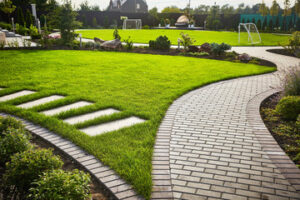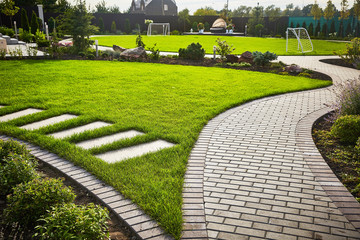Greensboro Commercial Landscaping Services play a vital role in enhancing the overall image of a business. A well-maintained landscape creates a positive first impression. Clients and visitors feel more comfortable in a visually appealing environment. Professional landscaping reflects attention to detail and professionalism.
Landscaping design involves more than planting grass and flowers. It requires strategic planning to balance aesthetics and functionality. Pathways, seating areas, and plant arrangements need to complement the building’s architecture. Professional landscapers assess these factors to create cohesive designs.
Seasonal changes affect landscape appearance and health. Professional maintenance ensures that plants, grass, and trees remain healthy year-round. Proper irrigation and soil treatments support growth. Adjustments in plant selection and placement enhance seasonal appeal.
Sustainable landscaping solutions reduce environmental impact. Drought-resistant plants and eco-friendly irrigation systems conserve water. Native plants adapt better to local conditions and require less maintenance. Professional landscapers select materials that promote long-term sustainability.
Lighting enhances both safety and aesthetics. Pathway lights, uplighting, and accent lighting improve visibility and highlight landscape features. Well-placed lighting increases security after dark. Professional installation ensures balanced illumination.
Tree care is essential for maintaining a healthy landscape. Pruning, disease control, and fertilization improve tree health and appearance. Overgrown branches pose safety risks and reduce visual appeal. Professional arborists handle complex tree care requirements.
Hardscaping adds structure to a commercial landscape. Retaining walls, decorative stones, and walkways create defined spaces. Professional landscapers design hardscapes that blend with natural elements. Durable materials enhance long-term performance.
Water features elevate landscape design. Fountains, ponds, and cascading waterfalls add movement and tranquility. Professional installation prevents leaks and structural issues. Balanced water circulation maintains water clarity and health.
Seasonal planting refreshes landscape appearance. Bright flowers in spring and evergreens in winter maintain visual interest. Professional landscapers adjust planting strategies to suit climate changes. Regular updates keep the landscape vibrant.
Lawn care improves overall landscape health. Professional mowing, aeration, and fertilization prevent patchiness and discoloration. Consistent care promotes even growth and rich color. Professional-grade equipment ensures precision.
Mulching enhances soil health and appearance. Organic and inorganic mulches regulate soil temperature and retain moisture. Professional application ensures even coverage. Proper mulching reduces weed growth and soil erosion.
Edging creates a polished look. Defined borders between grass, flower beds, and walkways improve visual appeal. Professional landscapers use precise techniques to maintain clean lines. Consistent edging prevents grass from overgrowing.
Drainage systems prevent water buildup and soil erosion. French drains, grading adjustments, and porous materials improve water flow. Professional landscapers assess slope and soil composition. Effective drainage protects plant health and landscape stability.
Plant selection influences both appearance and maintenance needs. Professional landscapers recommend plants suited to the soil, sunlight, and climate. Native species require less care and water. Balanced plant variety enhances color and texture.
Pest control protects plants from damage. Professional treatments target harmful insects without affecting beneficial ones. Regular monitoring prevents infestations. Natural solutions reduce environmental impact.
Weed management maintains a clean appearance. Professional landscapers use pre-emergent and post-emergent treatments. Manual removal ensures thorough coverage. Consistent weed control prevents overgrowth.
Ground cover options provide low-maintenance solutions. Gravel, moss, and creeping plants reduce the need for mowing. Professional selection enhances texture and color variation. Ground cover prevents soil erosion and improves moisture retention.
Seasonal decorations enhance commercial appeal. Wreaths, planters, and themed lighting add a festive touch. Professional placement ensures symmetry and balance. Temporary decorations create a welcoming atmosphere.
Soil health determines plant growth and resilience. Professional landscapers test soil composition and pH levels. Adjustments in fertilization and aeration improve nutrient absorption. Healthy soil supports strong root development.
Vertical landscaping maximizes limited space. Living walls, trellises, and hanging planters add greenery without reducing ground space. Professional installation ensures structural support. Vertical elements improve air quality and visual depth.
Outdoor seating areas create inviting spaces for clients and employees. Professional landscapers assess traffic flow and comfort. Durable materials withstand weather conditions. Thoughtful placement encourages relaxation and interaction.
Artificial turf provides a low-maintenance alternative to natural grass. Professional installation ensures even coverage and secure anchoring. Artificial grass resists discoloration and wear. It maintains a consistent look year-round.
Decorative stones and pebbles enhance texture and contrast. Professional landscapers select stones based on color and size. Proper placement improves drainage and soil stability. Decorative stones add a natural element to hardscaping.
Hedge trimming maintains clean lines and shapes. Professional landscapers use specialized tools for even cuts. Consistent trimming prevents overgrowth and improves symmetry. Well-maintained hedges frame the landscape.
Native plants adapt better to local climate and soil. Professional landscapers assess growing conditions and plant compatibility. Native species require less water and care. They improve biodiversity and resilience.
Irrigation systems ensure consistent water distribution. Professional installation includes timers and adjustable flow rates. Drip irrigation reduces water waste. Proper placement targets root zones directly.
Ground-level lighting increases safety and visual appeal. Path lights and recessed fixtures highlight walkways and plant beds. Professional installation ensures weather resistance. Balanced lighting prevents glare and shadows.
Plant grouping improves visual flow and maintenance efficiency. Professional landscapers assess growth patterns and color coordination. Grouped plants create natural balance. Strategic placement reduces watering and pruning needs.
Accent features highlight key areas of the landscape. Sculptures, decorative planters, and arbors add character. Professional placement ensures stability and visibility. Accent features enhance overall design cohesion.
Composting improves soil quality and reduces waste. Professional landscapers recommend suitable organic materials. Balanced compost increases nutrient content. Regular application improves plant health and growth.
Shrub maintenance controls shape and density. Professional trimming encourages new growth and balanced form. Pest and disease monitoring prevents damage. Healthy shrubs enhance overall landscape texture.
Perennial plants provide year-round color and structure. Professional landscapers select varieties suited to local climate. Perennials require less replanting and maintenance. Consistent color improves seasonal appeal.
Shade structures increase comfort and usability. Pergolas, umbrellas, and awnings provide relief from sun exposure. Professional installation ensures structural integrity. Shaded areas encourage outdoor use.
Decorative fencing enhances both privacy and design. Professional landscapers recommend materials based on weather resistance. Balanced height and spacing maintain visibility and airflow. Fencing defines boundaries and improves security.
Rock gardens add low-maintenance texture and contrast. Professional selection of rock sizes and colors creates visual depth. Proper placement ensures stability and drainage. Rock gardens require minimal upkeep.
Rain gardens manage runoff and improve drainage. Professional placement and plant selection increase water absorption. Native plants thrive in moisture-rich environments. Rain gardens reduce erosion and flooding.
Retaining walls create elevation and structure. Professional construction ensures stability and proper drainage. Decorative materials enhance visual appeal. Retaining walls prevent soil erosion and define planting areas.
Wind barriers protect plants from damage. Professional landscapers assess wind patterns and design suitable barriers. Shrubs, trees, and fencing reduce wind exposure. Barriers improve plant health and comfort.
Raised planters enhance visibility and access. Professional construction ensures even soil distribution. Elevated beds improve drainage and reduce weed growth. Raised planters increase planting flexibility.
Outdoor art enhances the landscape’s character. Sculptures, murals, and decorative panels add personality. Professional placement ensures balance and visibility. Art pieces create conversation points.
Professional landscapers manage every stage of the project. Design, installation, and maintenance follow a strategic plan. Open communication ensures alignment with business goals. Consistent care enhances long-term value and appeal.






